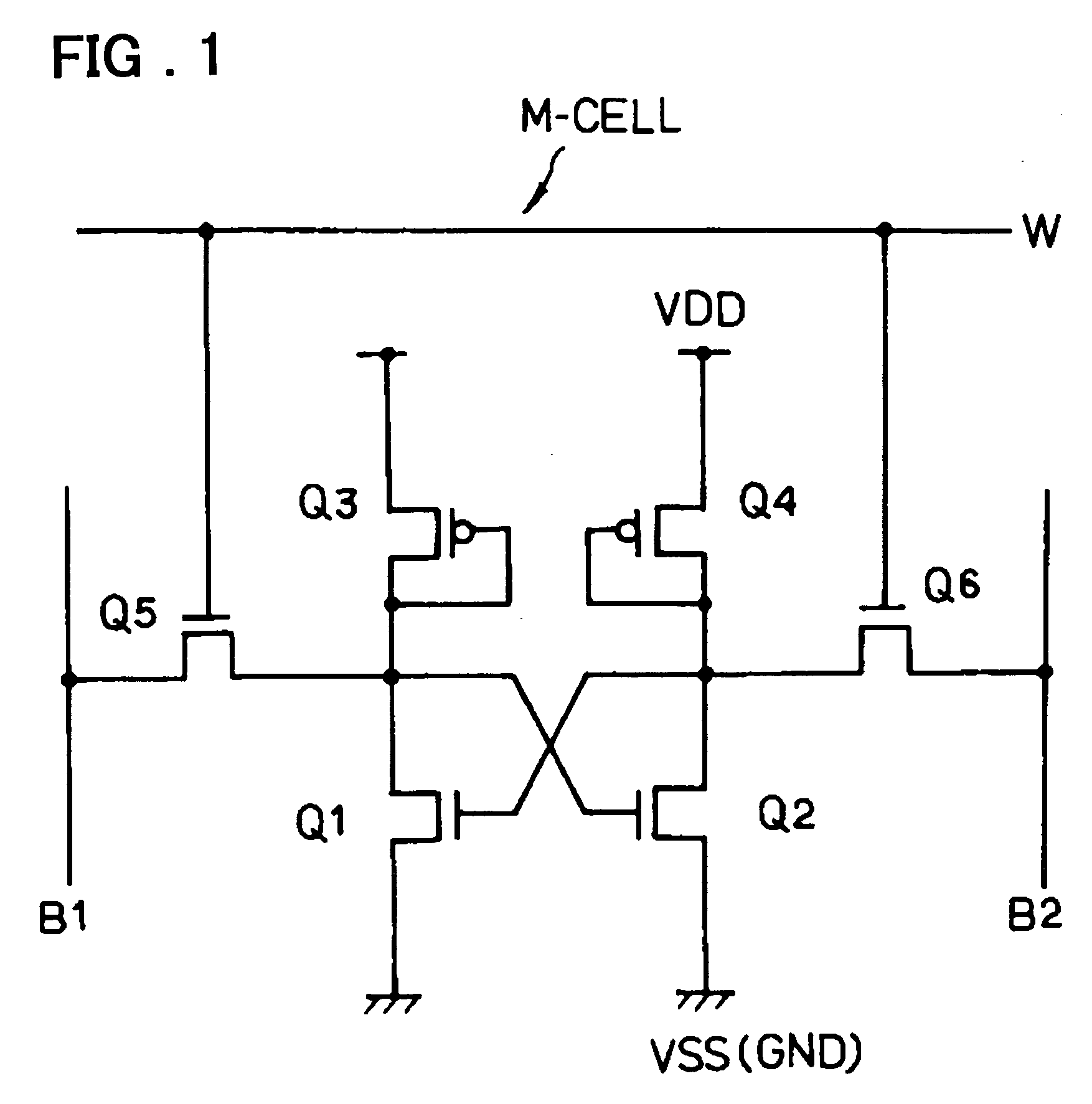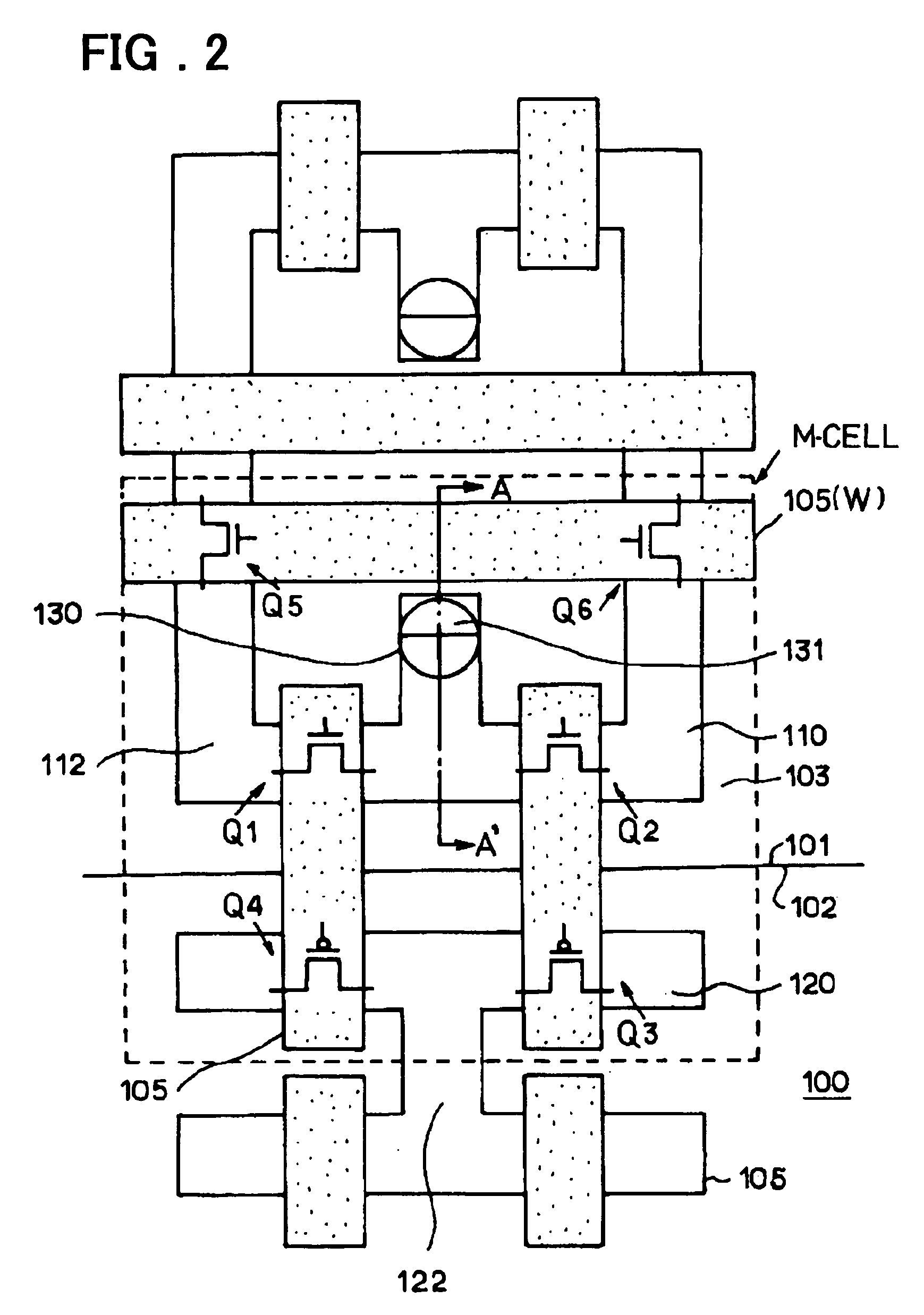Semiconductor device and manufacturing method thereof
a technology of memory device and semiconductor, which is applied in the direction of semiconductor devices, electrical devices, transistors, etc., can solve the problems of affecting the down-sizing of elements for smaller geometries, difficult to fix the well at a predetermined potential, and affecting the ability of the well to perform power supply to the well, etc., to achieve the effect of facilitating the manufacture of a contact structure for the well, reducing the number of well contacts, and increasing the chip siz
- Summary
- Abstract
- Description
- Claims
- Application Information
AI Technical Summary
Benefits of technology
Problems solved by technology
Method used
Image
Examples
first embodiment
[0037] Next, embodiments of the present invention will be described with reference to the drawings. FIG. 1 is a circuit diagram of an SRAM memory cell M-CELL according to the present invention. The M-CELL is made up of driver transistors Q1 and Q2, load transistors Q3 and Q4, and transfer transistors Q5 and Q6. The driver transistors Q1 and Q2 are constituted from a pair of N-type MOS transistors with gates thereof mutually cross-connected. The load transistors Q3 and Q4 are constituted from P-type MOS transistors connected to the nodes of the driver transistors Q1 and Q2, respectively. The transfer transistors Q5 and Q6 are constituted from a pair of N-type MOS transistors connected between the node of the driver transistor Q1 and a bit line B1 and between the node of the driver transistor Q2 and a bit line B2, respectively, and with the gates thereof connected to a word line W. The load transistors Q3 and Q4 are connected to a VDD, while the driver transistors Q1 and Q2 are connec...
second embodiment
[0049]FIG. 8 is a top plan layout diagram of a second embodiment of the present invention, and FIG. 9 is a cross sectional view taken along a B-B′ line of FIG. 8. The second embodiment is an example in which the GND contact 130 is provided for the P-well 101, and a VDD contact 140 is provided for the N-well 102. Though the SRAM memory cell M-CELL has the same circuit configuration as that shown in FIG. 1, pattern shapes of the gate electrodes and the source / drain regions of the MOS transistors are different. However, the basic configuration is the same as that in the first embodiment. Thus, by assigning the same reference characters to components that are equivalent to those in the first embodiment, detailed descriptions of them will be omitted. In the second embodiment, a dummy gate 105D is formed so as to form the GND contact 130 and the VDD contact 140, and in regions adjacent to this dummy gate 105, the GND contact 130 and the VDD contact 140 are formed.
[0050] More specifically...
third embodiment
[0058]FIG. 13 is a layout diagram of an SRAM memory cell according to a third embodiment of the present invention. FIG. 14 is a cross sectional view taken along a C-C′ line in FIG. 13, and shows an example of a variation of the first embodiment. By assigning the same reference characters to components that are equivalent to those in FIGS. 2 and 3, detailed descriptions of them will be omitted. In the third embodiment, a portion of the N+ diffusion layer 112 that constitutes the source / drain region 110 of an N-type MOS transistor is etched, and the GND contact 130 is formed in this etched region. More specifically, the N− diffusion layer 111 is not etched as in the first embodiment. Then, the portion of the N+ diffusion layer 112 is etched to a depth deeper than the depth of the N+ diffusion layer 112. The P+ diffusion layer 131 is formed in this etched region, thereby forming the GND contact 130.
[0059]FIGS. 15a and 15b show cross sectional views taken in the same direction as FIG. ...
PUM
 Login to View More
Login to View More Abstract
Description
Claims
Application Information
 Login to View More
Login to View More - R&D
- Intellectual Property
- Life Sciences
- Materials
- Tech Scout
- Unparalleled Data Quality
- Higher Quality Content
- 60% Fewer Hallucinations
Browse by: Latest US Patents, China's latest patents, Technical Efficacy Thesaurus, Application Domain, Technology Topic, Popular Technical Reports.
© 2025 PatSnap. All rights reserved.Legal|Privacy policy|Modern Slavery Act Transparency Statement|Sitemap|About US| Contact US: help@patsnap.com



